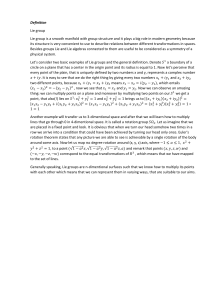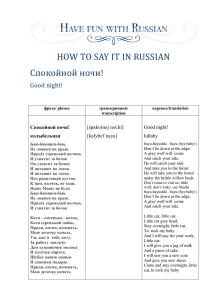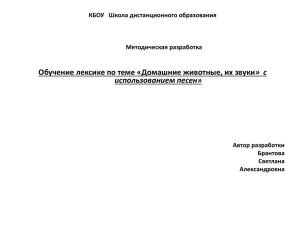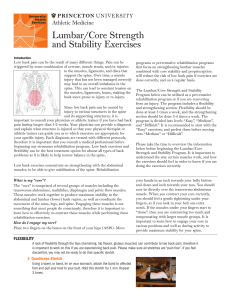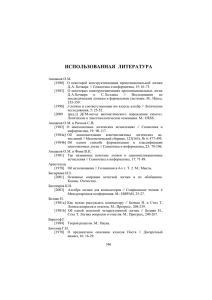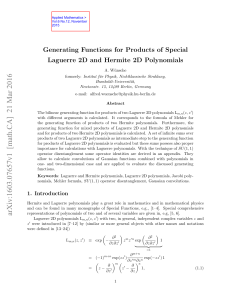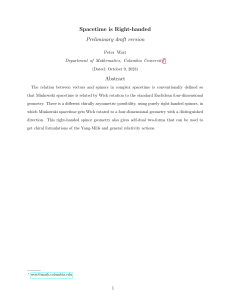ОТЧЕТ ЗА 2015 ГОД ПО ГРАНТУ ФОНДА ДИНАСТИЯ
реклама
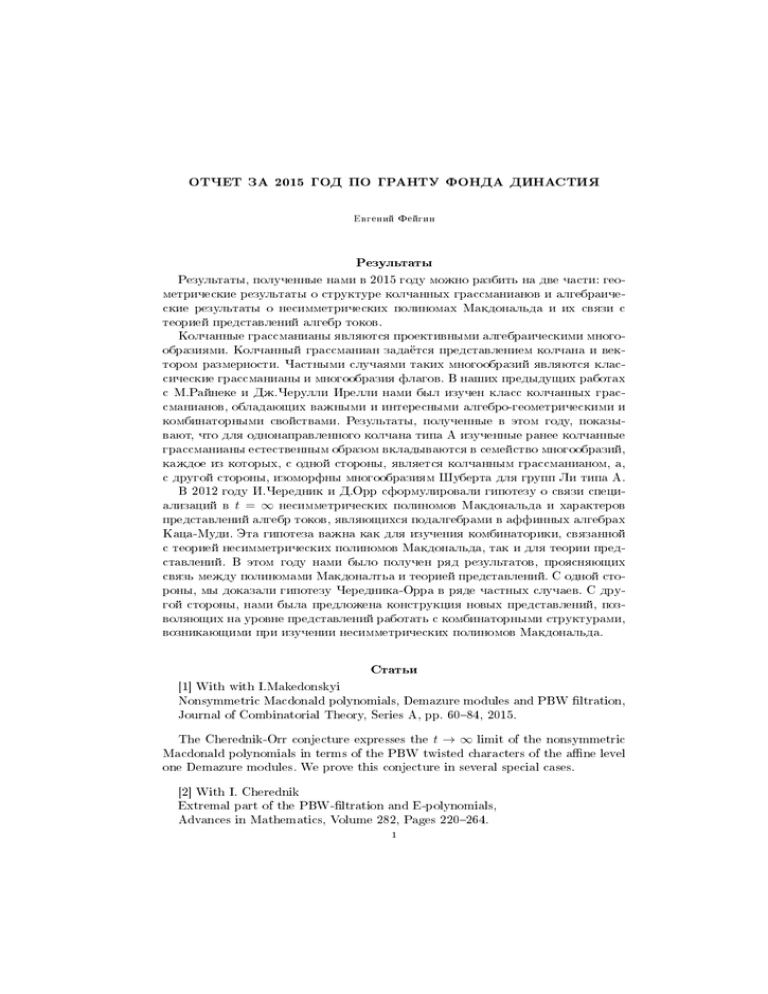
ÎÒ×ÅÒ ÇÀ 2015 ÃÎÄ ÏÎ ÃÐÀÍÒÓ ÔÎÍÄÀ ÄÈÍÀÑÒÈß Åâãåíèé Ôåéãèí Ðåçóëüòàòû Ðåçóëüòàòû, ïîëó÷åííûå íàìè â 2015 ãîäó ìîæíî ðàçáèòü íà äâå ÷àñòè: ãåîìåòðè÷åñêèå ðåçóëüòàòû î ñòðóêòóðå êîë÷àííûõ ãðàññìàíèàíîâ è àëãåáðàè÷åñêèå ðåçóëüòàòû î íåñèììåòðè÷åñêèõ ïîëèíîìàõ Ìàêäîíàëüäà è èõ ñâÿçè ñ òåîðèåé ïðåäñòàâëåíèé àëãåáð òîêîâ. Êîë÷àííûå ãðàññìàíèàíû ÿâëÿþòñÿ ïðîåêòèâíûìè àëãåáðàè÷åñêèìè ìíîãîîáðàçèÿìè. Êîë÷àííûé ãðàññìàíèàí çàäà¼òñÿ ïðåäñòàâëåíèåì êîë÷àíà è âåêòîðîì ðàçìåðíîñòè. ×àñòíûìè ñëó÷àÿìè òàêèõ ìíîãîîáðàçèé ÿâëÿþòñÿ êëàññè÷åñêèå ãðàññìàíèàíû è ìíîãîîáðàçèÿ ôëàãîâ.  íàøèõ ïðåäûäóùèõ ðàáîòàõ ñ Ì.Ðàéíåêå è Äæ.×åðóëëè Èðåëëè íàìè áûë èçó÷åí êëàññ êîë÷àííûõ ãðàññìàíèàíîâ, îáëàäàþùèõ âàæíûìè è èíòåðåñíûìè àëãåáðî-ãåîìåòðè÷åñêèìè è êîìáèíàòîðíûìè ñâîéñòâàìè. Ðåçóëüòàòû, ïîëó÷åííûå â ýòîì ãîäó, ïîêàçûâàþò, ÷òî äëÿ îäíîíàïðàâëåííîãî êîë÷àíà òèïà À èçó÷åííûå ðàíåå êîë÷àííûå ãðàññìàíèàíû åñòåñòâåííûì îáðàçîì âêëàäûâàþòñÿ â ñåìåéñòâî ìíîãîîáðàçèé, êàæäîå èç êîòîðûõ, ñ îäíîé ñòîðîíû, ÿâëÿåòñÿ êîë÷àííûì ãðàññìàíèàíîì, à, ñ äðóãîé ñòîðîíû, èçîìîðôíû ìíîãîîáðàçèÿì Øóáåðòà äëÿ ãðóïï Ëè òèïà À.  2012 ãîäó È.×åðåäíèê è Ä.Îðð ñôîðìóëèðîâàëè ãèïîòåçó î ñâÿçè ñïåöèàëèçàöèé â t = ∞ íåñèììåòðè÷åñêèõ ïîëèíîìîâ Ìàêäîíàëüäà è õàðàêòåðîâ ïðåäñòàâëåíèé àëãåáð òîêîâ, ÿâëÿþùèõñÿ ïîäàëãåáðàìè â àôôèííûõ àëãåáðàõ Êàöà-Ìóäè. Ýòà ãèïîòåçà âàæíà êàê äëÿ èçó÷åíèÿ êîìáèíàòîðèêè, ñâÿçàííîé ñ òåîðèåé íåñèììåòðè÷åñêèõ ïîëèíîìîâ Ìàêäîíàëüäà, òàê è äëÿ òåîðèè ïðåäñòàâëåíèé.  ýòîì ãîäó íàìè áûëî ïîëó÷åí ðÿä ðåçóëüòàòîâ, ïðîÿñíÿþùèõ ñâÿçü ìåæäó ïîëèíîìàìè Ìàêäîíàëòüà è òåîðèåé ïðåäñòàâëåíèé. Ñ îäíîé ñòîðîíû, ìû äîêàçàëè ãèïîòåçó ×åðåäíèêà-Îððà â ðÿäå ÷àñòíûõ ñëó÷àåâ. Ñ äðóãîé ñòîðîíû, íàìè áûëà ïðåäëîæåíà êîíñòðóêöèÿ íîâûõ ïðåäñòàâëåíèé, ïîçâîëÿþùèõ íà óðîâíå ïðåäñòàâëåíèé ðàáîòàòü ñ êîìáèíàòîðíûìè ñòðóêòóðàìè, âîçíèêàþùèìè ïðè èçó÷åíèè íåñèììåòðè÷åñêèõ ïîëèíîìîâ Ìàêäîíàëüäà. Ñòàòüè [1] With with I.Makedonskyi Nonsymmetric Macdonald polynomials, Demazure modules and PBW ltration, Journal of Combinatorial Theory, Series A, pp. 6084, 2015. The Cherednik-Orr conjecture expresses the t → ∞ limit of the nonsymmetric Macdonald polynomials in terms of the PBW twisted characters of the ane level one Demazure modules. We prove this conjecture in several special cases. [2] With I. Cherednik Extremal part of the PBW-ltration and E-polynomials, Advances in Mathematics, Volume 282, Pages 220264. 1 2 Åâãåíèé Ôåéãèí Given a reduced irreducible root system, the corresponding nil-DAHA is used to calculate the extremal coecients of nonsymmetric Macdonald polynomials in the limit t → ∞ and for antidominant weights, which is an important ingredient of the new theory of nonsymmetric q-Whittaker function. These coecients are pure q-powers and their degrees are expected to coincide in the untwisted setting with the extremal degrees of the so-called PBW-ltration in the corresponding nite-dimensional irreducible representations of the simple Lie algebras for any root systems. This is a particular case of a general conjecture in terms of the levelone Demazure modules. We prove this coincidence for all Lie algebras of classical type and for G2 , and also establish the relations of our extremal degrees to minimal q-degrees of the extremal terms of the Kostant q-partition function; they coincide with the latter only for some root systems. [3] With G. Cerulli Irelli and M. Reineke Schubert Quiver Grassmannians arXiv:1508.00264, submitted Quiver Grassmannians are projective varieties parametrizing subrepresentations of given dimension in a quiver representation. We dene a class of quiver Grassmannians generalizing those which realize degenerate ag varieties. We show that each irreducible component of the quiver Grassmannians in question is isomorphic to a Schubert variety. We give an explicit description of the set of irreducible components, identify all the Schubert varieties arising, and compute the Poincare polynomials of these quiver Grassmannians. [4] With I. Makedonskyi Weyl modules for osp(1, 2) and nonsymmetric Macdonald polynomials arXiv:1507.01362 submitted The main goal of our paper is to establish a connection between the Weyl modules of the current Lie superalgebras (twisted and untwisted) attached to osp(1, 2) and (2) (2)† the nonsymmetric Macdonald polynomials of types A2 and A2 . We compute the dimensions and construct bases of the Weyl modules. We also derive explicit formulas for the t = 0 and t = ∞ specializations of the nonsymmetric Macdonald polynomials. We show that the specializations can be described in terms of the Lie superalgebras action on the Weyl modules. Êîíôåðåíöèè è ñåìèíàðû [1] Conference "Enveloping Algebras and Geometric Representation Theory Oberwolfach, 10 May 16 May, 2015. [2] Workshop "On the Interaction of Representation Theory with Geometry and Combinatorics Bonn, 22 May 02 April, 2015. Talk Abelianization and ane Grassmannians". [3] Workshop "Aspects of Lie theory Rome, Italy, January 710, 2015. [4] International summer school "Theoretical problems of physics of fundamental interactions Zelenogorsk, 19 July 31 July, 2015. Talk Solitons, vertex operators and symmetries". [5] Summer school "Lie algebras, algebraic groups and invariants theory Samara, 22 June 27 June, 2015. ÎÒ×ÅÒ ÇÀ 2015 ÃÎÄ ÏÎ ÃÐÀÍÒÓ ÔÎÍÄÀ ÄÈÍÀÑÒÈß 3 Talk Poincare-Birkho-Witt ltration and ag varieties Ïðåïîäàâàíèå [1] Ane Lie algebras and applications, from 2nd year to PhD students, SeptemberDecember 2015, 2 hours per week. Program Ane Lie algebras form one of the most well-known and popular classes of innite-dimensional Lie algebras. During the last 20 years, they attracted attention of many mathematicians throughout the world due to the beautiful and rich structure theory and representation theory. The theory of ane Kac-Moody Lie algebras has important applications in the number theory, algebraic geometry and in mathematical physics. Program: 1. Simple Lie algebras. 2. Ane Kac-Moody Lie algebras: basic denitions. 3. Ane Kac-Moody Lie algebras: integrable representations. 4. Ane sl2 : representations and theta functions. 5. Boson-fermion correspondence and Schur polynomials. 6. Ane algebras, theta functions and modular forms. 7. Vertex operator construction of representations. Textbooks: 1. Kac, V. Innite dimensional Lie algebras, Cambridge University Press (1994). 2. Kac V., Raina A. Bombay lectures on Highest weight representations of intedimensional Lie algebras (WS, 1987) 3. Pressley, A., Segal, G. (1986), Loop groups. 4. Di Francesco, P., Mathieu, P., Senechal, D. (1997), Conformal Field Theory, Springer-Verlag. 5. Kumar, S., Kac-Moody Groups, their Flag Varieties and Representation Theory, 2012, Springer.
